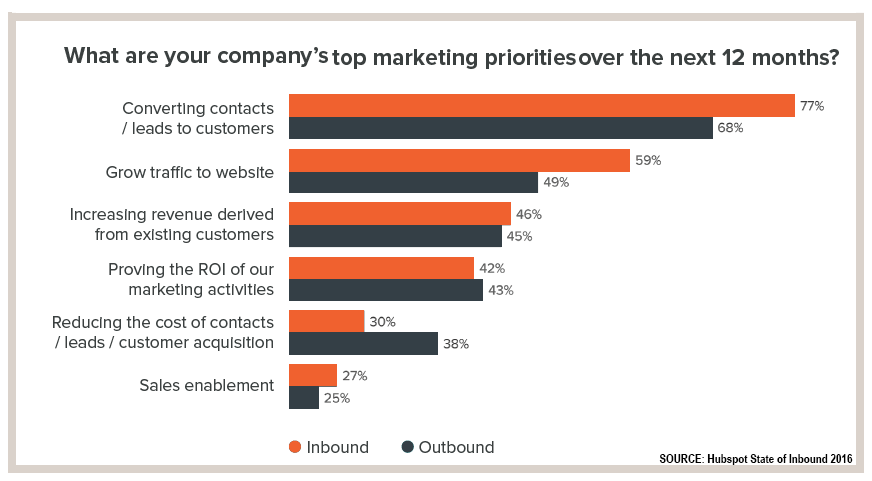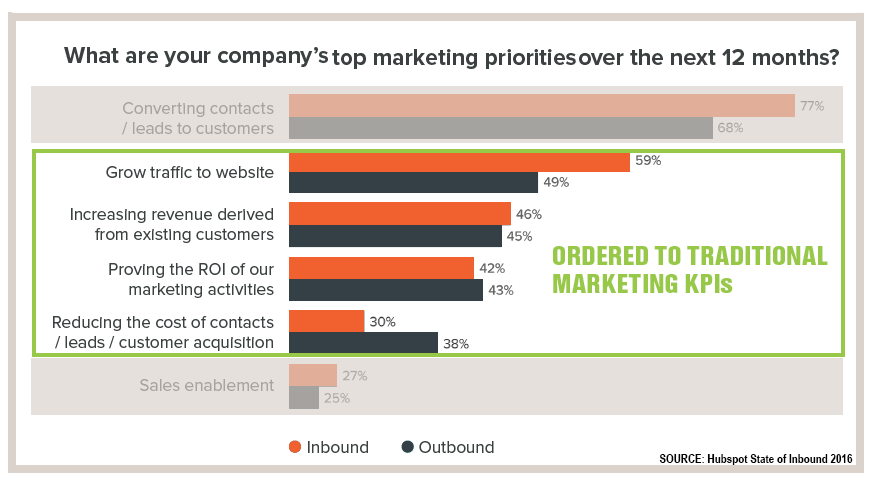Improving Sales Enablement Will Save Content Marketing
The one thing that marketing can do to help sales get more into and through the pipeline more quickly is being prioritized very low by marketing teams across the globe. 2016’s State of Inbound Marketing report by Hubspot contains many ‘hidden in plain sight’ warnings about the current fragile state of the practice of inbound and content marketing, but perhaps one of the most glaring is the fact that marketing is not prioritizing sales enablement very high. In fact, of all the reported marketing team priorities, improving sales enablement is the very lowest.

Content marketing and inbound marketing work, and the tactic is here to stay. However, make no mistake about it, this is a very real problem that carries with it the potential to be incredibly disruptive to how companies are structuring their teams, their sales and marketing technology stack and their go to market objectives. Top line growth is the business of both sales and marketing. Not to suggest that operational efficiency is not important, but if there is no steady increase of revenue all the operational efficiency the world will not matter. Left unaddressed the misalignment between sales and marketing will at best result in sales professionals continuing to go it alone where their pipeline develop is concerned. The worst case is that marketing teams and technology will become unsustainable and trigger a technology crash in the marketing automation category.
An exaggeration? Time will tell but just look at the detail in the report a little more closely.

After revenue generation, nearly all respondents are prioritizing the tactical techniques directly aligned to traditional key performance indicators (KPIs). Increasing traffic, improving marketing efficiency, and getting a higher ratio of lead volume from marketing investments ultimately all drive towards converting leads over to qualified sales opportunities. However, as we have previously written about the content marketing problem, sales turns to marketing leads only about 22% of the time. If this percentage stays where it is a higher volume of leads is more likely to be bottlenecked by the desire of sales professionals doing their own prospecting and business development. Marketing has a choice to continue to work on incrementally improving their status quo, or adjusting to raise the priority of sales enablement.

Given the current level of sales reps prospecting, placing a high priority on sales enablement should have an immediate impact on the size of the sales pipeline, deal speed, and revenue. So instead of forcing upon sales a potentially severe change in how they are conducting their efforts, marketers must meet them where they are by delivering to them tools that are going to help them in every single stage of the sales process.
Not a new concept of course. In the 2000s business to business sales representatives had supporting team members that would play the role of sales enablement at every deal stage. From industry experts brought in early to get the deal in the pipeline to solution architects who would craft custom examples of how the product or service would meet the immediate demands of the buyer, sales pros had plenty of air coverage. Today this supporting infrastructure is a fraction of what it once was leaving the sales rep to virtually go it alone when they seek to get a prospect into their pipeline.
The tempting reaction here is to believe that increasing the amount of sales enabling activity that the marketing team delivers will demand an increase in cost. But that is the wrong way to consider the problem. What marketing must do is examine not just their performance against traditional KPIs, but also against how well their efforts are arming sales reps with all they need in the early stages of their pipeline development. This performance is best evaluated by determining where marketing content is coming from. If it is limited almost exclusively to the marketing team, then that is the place to start. Marketing cannot be the sole providers of the narrative that helps sales get deals into the pipeline and speed movement of a deal to close. Rather marketing must be enablers across the entire company. Working to make every area of the business poised to identify information that is going to help pipeline development or deal acceleration.
Is the growing content marketing problem insurmountable? No, it is not, but it might get worse before it gets better. The best way to avoid it getting worse is to increase the priority of improving sales enablement.

